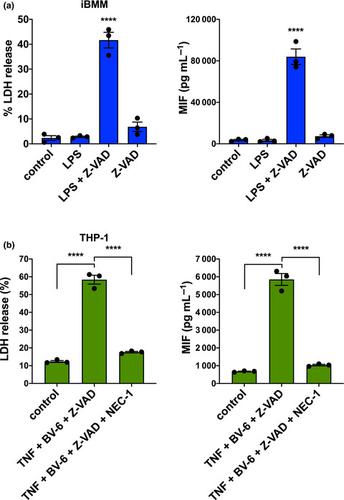当前位置:
X-MOL 学术
›
Immunol. Cell Biol.
›
论文详情
Our official English website, www.x-mol.net, welcomes your
feedback! (Note: you will need to create a separate account there.)
Necrotic cell death increases the release of macrophage migration inhibitory factor by monocytes/macrophages.
Immunology and Cell Biology ( IF 3.2 ) Pub Date : 2020-07-12 , DOI: 10.1111/imcb.12376 Wendy Dankers 1 , Md Abul Hasnat 1 , Vanesa Swann 1 , Arwaf Alharbi 2, 3 , Jacinta Pw Lee 1 , Megan A Cristofaro 1 , Michael P Gantier 2, 3 , Sarah A Jones 1 , Eric F Morand 1 , Jacqueline K Flynn 1 , James Harris 1
Immunology and Cell Biology ( IF 3.2 ) Pub Date : 2020-07-12 , DOI: 10.1111/imcb.12376 Wendy Dankers 1 , Md Abul Hasnat 1 , Vanesa Swann 1 , Arwaf Alharbi 2, 3 , Jacinta Pw Lee 1 , Megan A Cristofaro 1 , Michael P Gantier 2, 3 , Sarah A Jones 1 , Eric F Morand 1 , Jacqueline K Flynn 1 , James Harris 1
Affiliation

|
Macrophage migration inhibitory factor (MIF) is a pleiotropic inflammatory molecule with both cytokine and noncytokine activity. MIF is constitutively released from multiple cell types via an unconventional secretory pathway that is not well defined. Here, we looked at MIF release from human and mouse monocytes/macrophages in response to different stimuli. While MIF release was not significantly altered in response to lipopolysaccharide or heat‐killed Escherichia coli, cytotoxic stimuli strongly promoted release of MIF. MIF release was highly upregulated in cells undergoing necrosis, necroptosis and NLRP3 inflammasome‐dependent pyroptosis. Our data suggest that cell death represents a major route for MIF release from myeloid cells. The functional significance of these findings and their potential importance in the context of autoimmune and inflammatory diseases warrant further investigation.
中文翻译:

坏死细胞死亡增加了单核细胞/巨噬细胞释放巨噬细胞迁移抑制因子。
巨噬细胞迁移抑制因子 (MIF) 是一种具有细胞因子和非细胞因子活性的多效性炎症分子。MIF 是由多种细胞类型通过尚未明确定义的非常规分泌途径组成性释放的。在这里,我们研究了人类和小鼠单核细胞/巨噬细胞对不同刺激的 MIF 释放。虽然 MIF 的释放没有显着改变对脂多糖或热灭活的大肠杆菌的反应,细胞毒性刺激强烈促进 MIF 的释放。MIF 释放在经历坏死、坏死性凋亡和 NLRP3 炎症小体依赖性细胞焦亡的细胞中高度上调。我们的数据表明,细胞死亡是骨髓细胞释放 MIF 的主要途径。这些发现的功能意义及其在自身免疫和炎症性疾病中的潜在重要性值得进一步研究。
更新日期:2020-07-12
中文翻译:

坏死细胞死亡增加了单核细胞/巨噬细胞释放巨噬细胞迁移抑制因子。
巨噬细胞迁移抑制因子 (MIF) 是一种具有细胞因子和非细胞因子活性的多效性炎症分子。MIF 是由多种细胞类型通过尚未明确定义的非常规分泌途径组成性释放的。在这里,我们研究了人类和小鼠单核细胞/巨噬细胞对不同刺激的 MIF 释放。虽然 MIF 的释放没有显着改变对脂多糖或热灭活的大肠杆菌的反应,细胞毒性刺激强烈促进 MIF 的释放。MIF 释放在经历坏死、坏死性凋亡和 NLRP3 炎症小体依赖性细胞焦亡的细胞中高度上调。我们的数据表明,细胞死亡是骨髓细胞释放 MIF 的主要途径。这些发现的功能意义及其在自身免疫和炎症性疾病中的潜在重要性值得进一步研究。











































 京公网安备 11010802027423号
京公网安备 11010802027423号